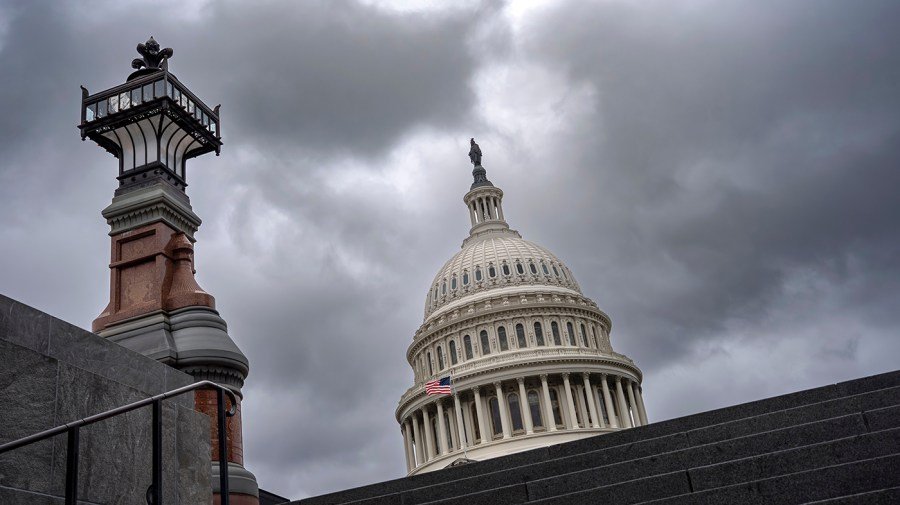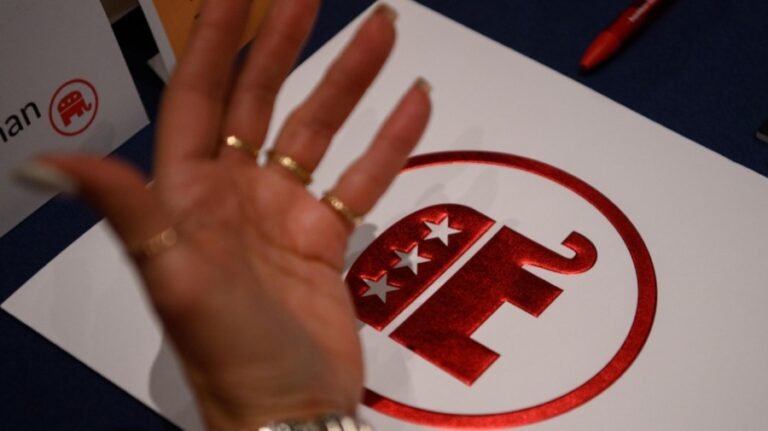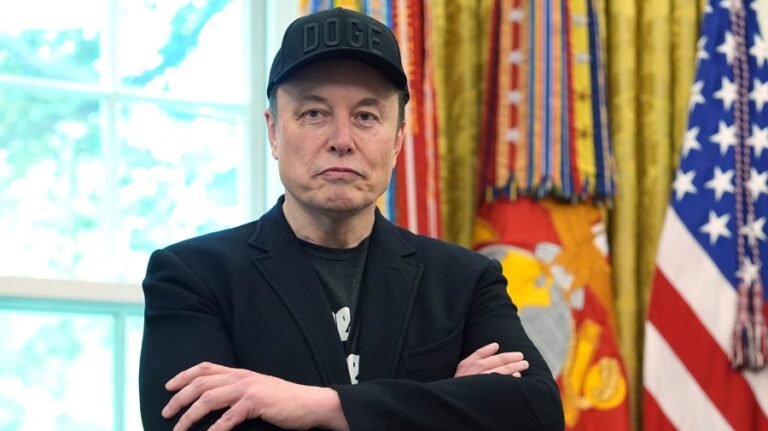
Morning Report is The Hill’s a.m. newsletter. Subscribe here.
▪ Shutdown ties second-longest ever
▪ Dems accuse ICE of regularly arresting citizens
▪ Court allows Portland National Guard deployment
▪ Universities reject Trump’s funding offer
The ongoing government shutdown is now tied for the second-longest in U.S. history, reaching its 21st day, still with no end in sight.
It tied the shutdown of December 1995-January 1996 during the Clinton administration and will surpass it for the second-longest on Wednesday. It’s only eclipsed by the record-long shutdown during President Trump’s first term, which lasted 35 days.
With no major negotiations happening between Republicans and Democrats, how this current shutdown will end seems unclear. Both sides appear committed to their demands.
But this has also been the case in previous shutdowns until a deal was reached, restoring full government services.
Here’s how the three other shutdowns that lasted longer than a week came to an end:
1995-1996
A standoff between former President Clinton and congressional Republicans, led by then-House Speaker Newt Gingrich (R-Ga.), began when Clinton vetoed a spending bill that would have issued a range of budget cuts to social programs and Medicare and tax cuts for the wealthy.
The government had shut down for just less than a week in November 1995 before a temporary funding agreement reopened services to give lawmakers a few more weeks to negotiate. But both sides remained adamant, causing a second shutdown on Dec. 16 of that year.
What followed was the longest shutdown in U.S. history up to that point; none before it had gone on longer than a week.
Public opinion ultimately weighed heavily in ending the shutdown, as polls showed most of the public blamed Republicans for shutting down the government. The GOP caved and accepted Clinton’s budget proposal.
2013
Like the current shutdown, the Affordable Care Act (ACA) played a key role in the 2013 shutdown in the first year of former President Obama’s second term.
Congressional Republicans were insistent on a continuing resolution (CR) that included rollbacks of key parts of the ACA. One of the provisions that the GOP included in its bill also would have delayed implementation of ObamaCare by one year.
Texas Sen. Ted Cruz (R), then a first-term senator, was a key driver of the Republican push to strip funding from Obama’s signature accomplishment, raising his profile within the party.
But polling showed the public blamed Republicans more for shutting down the government, and the GOP wasn’t unified behind this strategy, as some including then-Senate Minority Leader Mitch McConnell (R-Ky.) stepped in to negotiate a deal.
Congress ultimately passed a CR without major changes to the ACA, which Obama signed.
2018-2019
The most recent major shutdown centered on Trump’s insistence on Congress providing billions in funding to build a wall on the U.S.-Mexico border, a key campaign promise.
Democrats were uniformly opposed to a House-passed bill that included the funding, setting the stage for a standoff that lasted a record 35 days. The shutdown was also unique in that it started during a lame-duck Congress in December 2018, with Democrats set to take control of the House after the new year.
Polls showed most Americans didn’t view Trump’s holdup for border wall funding as worth the shutdown and blamed the White House and GOP. After Democrats took control of the House, Trump showed openness to a measure to reopen the government.
He later declared a national emergency to direct funding to a border wall without needing congressional authorization.
In each of these shutdowns, the public’s view was key in causing one side, each time Republicans, to blink and end the shutdown. But polls so far have been a bit less definitive as to whom the public is blaming for this shutdown, possibly giving both sides confidence that they can win the battle.
▪ CNBC: White House economic adviser says shutdown could end this week.
▪ The Washington Post: “How is this shutdown different from other shutdowns?”
FIRST IN THE HILL: Reps. Jamie Raskin (D-Md.) and Pramila Jayapal (D-Wash.) accused U.S. Immigration and Customs Enforcement (ICE) agents of routinely arresting U.S. citizens, demanding stats on the number of those detained.
A letter dated Monday outlines a number of recent arrests of U.S. citizens taken into custody by ICE, faulting the agency for aggressive tactics and a failure to swiftly review immigration status. ProPublica recently found at least 170 cases of such arrests, with some U.S. citizens held for more than 24 hours.
“DHS and ICE continue to wrongfully detain U.S. citizens—sometimes with violent force—while failing to investigate these cases with the urgency and care required,” the two wrote, adding that the Department of Homeland Security (DHS) was in “clear violation” of its own policy.
The letter comes amid rising tensions in Chicago, the latest city where Trump has surged immigration enforcement, sparking widespread protests that have led to notable arrests beyond ICE — including of pastors.
DHS largely rebuffed the lawmakers when pressed on the topic earlier this year, prompting cries from the Democrats that they received a “flippant and unserious” response.
“ICE has significant protections in place to ensure U.S. citizens are not mistakenly arrested, detained, or removed, and claims to U.S. citizenship are evaluated as quickly and thoroughly as possible,” the agency wrote, refusing to turn over any of the requested figures.
– Rebecca Beitsch
Smart Take with Blake Burman
A big ruling came Trump’s way Monday on one of his signature issues. A panel of judges in the 9th Circuit Court of Appeals allowed for the federalization of Oregon National Guard troops. “Even if the President may exaggerate the extent of the problem on social media, this does not change that other facts provide a colorable basis to support the statutory requirements,” the order reads.
NewsNation legal contributor Jesse Weber described it as a major decision. “It’s basically affirming a wide grasp of power, a wide view of power of the president,” Weber said. “Essentially what they said is the situation in Portland is so real and so bad that you have to defer to the president’s assessment of the situation on the ground.”
This is just one court and one jurisdiction, but now we await to see how the White House responds in Portland, and whether they view this ruling as a green light for other cities. Keep in mind, the 9th Circuit covers out west, and the president has recently mentioned San Francisco as the next city on his crime crackdown list.
Burman hosts “The Hill” weeknights, 6p/5c on NewsNation.
3 Things to Know Today
1. Ukrainian President Volodymyr Zelensky said his meeting with Trump was “positive” even though he failed to secure the Tomahawk missiles he desires. Zelensky told reporters he doesn’t believe Trump wants an “escalation” with the Russians until he meets with them.
2. Authorities say a man who planned to carry out a shooting at Hartsfield-Jackson Atlanta International Airport was arrested before opening fire following a tip from the man’s family that he was planning an attack.
3. Demolition crews have started to tear down the White House’s East Wing to start construction on Trump’s planned ballroom. The ballroom is expected to be 90,000 square feet and the construction is expected to cost $200 million.
Leading the Day

PORTLAND DEPLOYMENT: A federal appeals court has lifted a judge’s block on Trump’s deployment of the National Guard to Portland, Ore., allowing it to go forward while court battles play out.
The 2-1 ruling from the three-judge panel of the U.S. Court of Appeals for the 9th Circuit lifted the federal judge’s ruling that halted Trump’s deployment.
“Rather than reviewing the President’s determination with great deference, the district court substituted its own determination of the relevant facts and circumstances,” the unsigned order from the appeals court panel read.
The ruling comes as another legal battle plays out over Trump’s attempts to deploy troops in Chicago. A federal appeals court rejected the administration’s request to lift a lower court order blocking the deployment, finding “insufficient evidence of rebellion or a danger of a rebellion.”
Trump requested the Supreme Court permit him to deploy the guard in the city. He’s also openly floated invoking the Insurrection Act to give him the authority to call up federal troops to put down a domestic rebellion or insurrection.
▪ The Guardian: “Trump claims ‘unquestioned power’ in vow to send troops to San Francisco.”
▪ Oregon Public Broadcasting: A timeline of Trump’s focus on Portland.
AMAZON OUTAGE: The outage of Amazon Web Services (AWS) on Monday underscored the fragility of web-connected systems and how many platforms rely on the same services to function.
AWS, which provides cloud-computing services for a wide range of platforms, first reported “increased error rates” in the “US-East-1″ region located in Northern Virginia shortly after 3 a.m. EDT before mitigating the issue a few hours later. But the effects were felt throughout the day.
The outages impacted everything from social media apps like Snapchat to retail stores like Starbucks to home security systems like Ring. It affected numerous facets of daily life but also major platforms used by companies throughout the U.S. and the world.
While Amazon said it had resolved the issues by early Monday morning, others still lingered on various platforms throughout the afternoon.
The outage was reminiscent of the one that affected the cybersecurity company CrowdStrike after it processed a faulty update, causing flights to be grounded, banks and hospital systems to be pushed offline and media outlets to be off the air.
Both incidents were caused by glitches and not any hack or cybersecurity attack, but they underscore the fragility of much of the online ecosystem with so many platforms using the same system.
The Hill’s Julia Shapero and Sarah Fortinsky have a list of platforms affected by the outage.
▪ Los Angeles Times: Why did the AWS outage affect so many platforms?
▪ Axios: “AWS outage spotlights the global economy’s fragile foundations.”
TRUMP MOTTO: Trump’s attacks on Saturday’s “No Kings” protests are underscoring his strategy of mocking his political rivals and abiding by two simple rules — always be on offense and hit harder than they hit you.
The Hill’s Amie Parnes and Brett Samuels report how incendiary language was on display as Trump, his aides and congressional Republicans verbally attacked those participating in the nationwide protests that drew more than 7 million participants.
That includes Trump’s Truth Social post of him in an AI-generated video dropping excrement on protesters and White House press secretary Karoline Leavitt doubling down on her claim that Democrats’ “main constituency” is terrorists, criminals and those in the country illegally.
Trump has used inflammatory language for years, calling his opponents “scum” and the “enemy within.” But Trump’s second term is following the rulebook of always being on the attack and never backing down in the face of criticism, Parnes and Samuels report.
▪ The Hill: Trump reveals irritation after No Kings protests.
TRUMP’S PEACE PRIZE: Trump is set to participate in a ceremony for the Richard Nixon Foundation’s Architect of Peace Award later this morning in the Oval Office.
A foundation spokesperson told RealClearPolitics that Trump is receiving the award and is the first sitting president to get it.
The award is given to individuals who embody former President Richard Nixon‘s “lifelong goal of shaping a more peaceful nation.”
Passed recipients have included Henry Kissinger, former President George W. Bush and Trump’s first-term secretary of State and national security adviser, Mike Pompeo and Robert O’Brien, among others.
Trump openly campaigned to win the Nobel Peace Prize this year, particularly in the aftermath of securing a deal to end the fighting between Israel and Hamas in Gaza. But the award this year went to María Corina Machado, a Venezuelan opposition leader who has pushed back against authoritarian leader Nicolás Maduro.
VANCE TO ISRAEL: Vice President Vance is heading to Israel as the U.S. tries to keep the tentative peace agreement in place following a round of fighting with Hamas.
He’ll join Trump’s Middle East envoy Steve Witkoff and Trump’s son-in-law Jared Kushner, who have been back in Israel to try to help keep the peace. Israel reported that Hamas militants fired on its soldiers over the weekend, killing two. Israel responded by launching airstrikes on parts of southern Gaza to go after the militants.
Both sides have stated their commitment to keeping the ceasefire in place after the incident, but it has made the future of the agreement uncertain. Vance is set to meet with Israeli officials, including Prime Minister Benjamin Netanyahu.
Several Trump officials told The New York Times that members of the administration are concerned Netanyahu may vacate the peace deal.
AUSTRALIA DEAL: Trump signed a multibillion-dollar agreement with Australian Prime Minister Anthony Albanese on Monday to increase cooperation on rare earth minerals.
The agreement came while Albanese was visiting the White House for a bilateral meeting and lunch. Albanese said the deal calls for a $1 billion contribution from the U.S. and Australia over the next six months.
It includes investments in joint projects between the countries on rare earths and U.S. investments in Australia to boost processing of critical minerals.
The agreement is key as China recently announced new restrictions on exporting critical minerals. Trump administration officials have said they plan to be more active in ensuring access to rare earths in response to China’s moves.
But Trump told reporters that he would still meet with Chinese President Xi Jinping later this month at a summit in South Korea, after suggesting last week that he might not because of the restrictions.
▪ The Hill: Trump swipes at Australian ambassador who previously criticized him.
Zoom In

COLLEGE COMPACT FAILING: At least seven of the original nine universities to which Trump offered favorable funding status in exchange for institutional changes have publicly rejected the deal as of the administration’s Monday deadline.
The rejections have generally centered on the schools’ beliefs that the administration’s demands violate academic freedom and their values, The Hill’s Lexi Lonas Cochran reports.
The compact offers preferential funding treatment if universities overhaul certain policies on hiring, admissions and campus culture and reduce their numbers of admitted foreign students.
The schools that have publicly rejected the offer are the Massachusetts Institute of Technology, Brown University, the University of Pennsylvania, the University of Southern California, the University of Virginia, Dartmouth College and the University of Arizona. Vanderbilt University indicated it provided feedback on the offer without saying yes or no, while the University of Texas at Austin hasn’t issued a public response.
Experts said they don’t expect any universities to take the deal as the demands were likely nonstarters, but this likely won’t be the end of pressure from the administration, which has already said the offer would be expanded to other schools.
▪ Forbes: Trump ramps up pressure, expands compact offer to all institutions.
BIDEN FINISHES CANCER TREATMENT: Former President Biden has finished a round of radiation treatment to address the aggressive form of prostate cancer that he was diagnosed with earlier this year.
A Biden spokesperson said the treatment lasted several weeks and the former president is “doing well.” A spokesperson previously indicated that Biden was undergoing radiation therapy and hormone treatment to treat the cancer.
Biden expressed appreciation for the outpouring of support for him after he was diagnosed in May.
“Cancer touches us all. Like so many of you, Jill and I have learned that we are strongest in the broken places,” Biden wrote on X at the time.
SANTOS CLEMENCY DIVIDES GOP: Trump’s decision to commute the sentence of former Rep. George Santos (R-N.Y.) is just his latest instance of granting leniency to Republicans convicted of crimes, but this particular commutation is causing a split among the GOP.
Santos’s attorney credited a group of MAGA movement members in the House for Santos getting out of prison, including Reps. Marjorie Taylor Greene (R-Ga.), Lauren Boebert (R-Colo.) and Tim Burchett (R-Tenn.). But many Republicans, including those who led calls for Santos to be expelled from the House, aren’t happy about his sentence being commuted, The Hill’s Emily Brooks reports in her newsletter, The Movement, later this morning. Sign up for The Movement here
Brooks reports how Santos’s release underscores the political reality that when you’re a Republican loyal to Trump, he’ll let you do it. Throughout Trump’s second term, he hasn’t been shy about regularly pardoning and commuting the sentences of former Republican lawmakers and political supporters convicted of various crimes.
Trump mentioned in his Truth Social post announcing the commutation that Santos “had the Courage, Conviction, and Intelligence to ALWAYS VOTE REPUBLICAN!”
▪ ABC News: Santos says he’s not getting away with his crimes.
▪ The Hill: “Santos’s fines, restitution wiped out by Trump clemency order.”
Elsewhere

JAPAN’S GLASS CEILING: Japan has elected its first female prime minister, with conservative Sanae Takaichi succeeding Prime Minister Shigeru Ishiba following a parliamentary vote Tuesday.
Takaichi’s Liberal Democratic Party (LDP) received a major boost on Monday when it signed a coalition agreement with the conservative Japan Innovation Party. The LDP is the major conservative and nationalist party in Japan.
Takaichi enters office at a difficult time for Japanese politics, coming off of Ishiba’s announcement of his resignation after just a year in office. She will have to address rising prices and propose economic stimulus measures to allay frustrations about the state of the country’s economy. She also has regional summits on the horizon.
A protégé of former Prime Minister Shinzo Abe, Takaichi is expected to emulate his economic and security policies and shift the LDP further to the right.
Despite her becoming Japan’s first female head of government in its history, some women aren’t celebrating as they view her leadership as a setback. She supports the imperial family’s male-only succession policy and opposes same-sex marriage and a revision to a civil law to allow separate last names for married couples, which would reduce pressure on women to give up their preferred name.
▪ NBC News: “Japan has its first female prime minister, but not all women are celebrating.”
▪ The New York Times: Japan’s new prime minister is a heavy metal drummer.
Opinion
No Kings isn’t the Tea Party, but there’s some overlap, writes The Hill’s Chris Stirewalt.
Rep. Erin Houchin (R-Ind.) writes in The Hill on Reestablishing the dignity of work.
The Closer

Singer Kenny Loggins is objecting to Trump’s use of his song “Danger Zone” in his AI video depicting Trump flying a fighter jet and dropping excrement on No Kings protesters.
“This is an unauthorized use of my performance of ‘Danger Zone.’ Nobody asked me for my permission, which I would have denied, and I request that my recording on this video is removed immediately,” Loggins said in a statement posted on his official website.
Loggins said the video was created with the “sole purpose of dividing us,” and that he doesn’t know why anyone would want their music used for that purpose.
The video was one of the ways that Trump mocked protesters who turned out for the nationwide rallies on Saturday.
Loggins is just the latest in a long line of musicians who have said Trump used their music without asking permission. Others in the past few years include the Foo Fighters, ABBA, Sinead O’Connor and Beyoncé.


